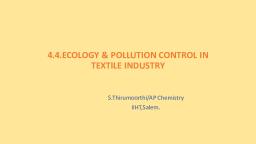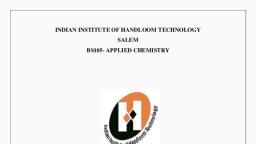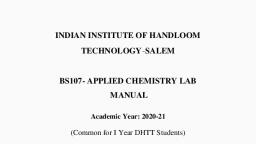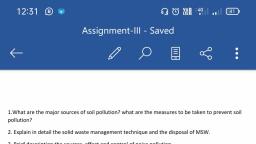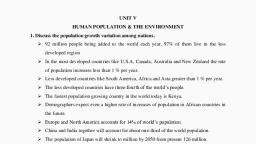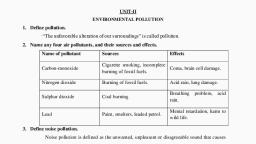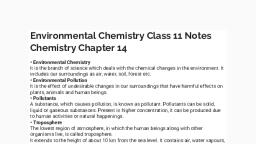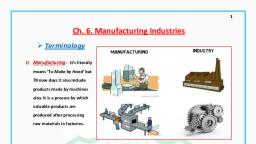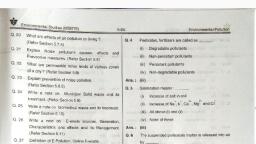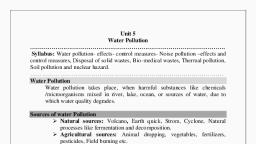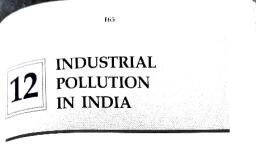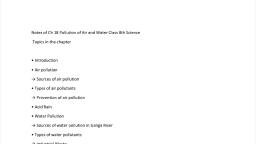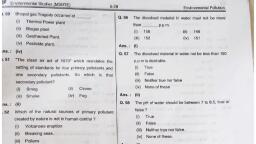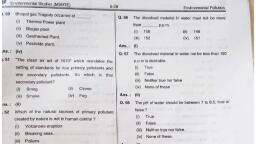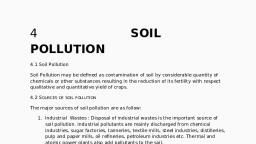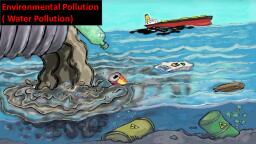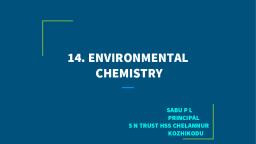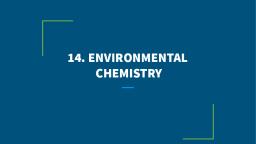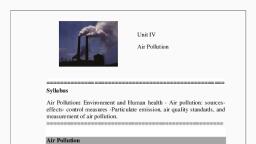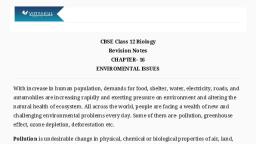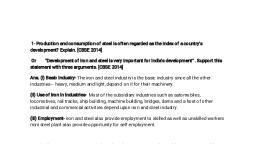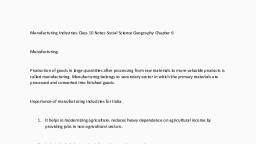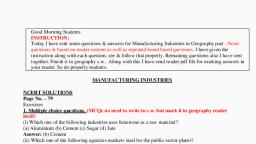Page 1 :
ECOLOGY & POLLUTION CONTROL IN TEXTILE INDUSTRY, UNIT -1:, 1. Environmental Pollution & its harmful effects on Human beings,, Vegetation Inert material and Physical features of Atmosphere., 2. Introduction of types of pollution viz. Air, Water, Soil, Noise, Radio, active Radiation Pollution, 3. Overview of Environmental Pollution in Textile Industry, 4. Brief description on Pollutants in Textiles, UNIT - II:, 1. Air-Pollution - Definition, causes of Air Pollution, 2. Classification, Sources & Characteristics of Important Air Pollutants, 3. Sources of Air Pollution in a Textile Mill, 4. Air quality standards, Out door air pollution &In door air pollution, UNIT-III:, 1. Water Pollution, 2. Classification of water pollutants, Various sources of waste water in wet, processing, 3. Characteristics of waste water --e.g. SS, TDS, DO, COD, BOD etc,, 4. Water conservation in Textile Industry, Various methods of waste, reduction, UNIT - IV:, 1. Methods of wastewater / effluent treatment i.e. Physical, Chemical and, Biological treatment., 2. Brief description of design and working of effluent treatment plant., 3. Methods of removal of colour from Textile Dye House waste, 4. Tolerance level of Effluents in Wet Processing of Textiles, 5. Impact of water pollution on Man, Marine life & Ecology of Textiles,, Solid wastes, its sources and sledge treatment., , 1
Page 2 :
UNIT-V;, 1. Noise Pollution, 2. It's effects and Preventive & Control of Noise pollution in Textile Industry, 3. New Challenges towards achievements of rigid standards in Textile, Processing Effluents, 4. Eco-Standards and Eco- Labels for Textiles, 5. ISO 14000 & current environment related to Textile Industry, REFERENCE BOOKS:, 1. Sewage Disposal & Air Pollution Engineering by S.K. Garg, 2. Environmental, , Pollution, , and, , Environmental, , Management, , by, , PadmanabhDwivedi, 3. A Text book of Environmental Studies by Thangamani &Shyamala, Thangamam, 4. Work shop on Environmental Pollution & Control in Textile Industry by, BTRA, , 2
Page 3 :
UNIT - I, ENVIRONMENTAL SEGMENTS, The environment may be considered to comprise of the following, segments., i., , Lithosphere, , ii., , Hydrosphere, , iii., , Biosphere, , iv., , Atmosphere, , Zonal Structure of the Atmosphere, , 3
Page 4 :
LITHOSPHERE, The mantle of rocks constituting the earth crust is called lithosphere., The soil covering rocks is also considered to be an important part of the, lithosphere., • The soil mainly consists of mixture of inorganic, organic mater and, water., • The inorganic material includes sodium (Na) pottasium (K), calcium, (Ca), Aluminum (Al), Iron (Fe). The organic matter includes organosulphur compounds, sugars and hemimaterials., HYDROSPHERE, This includes all the surface and ground water resources viz. oceans, sea,, river, lakes, glaciers, ice capes, ice bar, ground water and the water is locked, in rock mineral lying deep below the earth crust., Earth is called blue planet because about 80% of its surface is covered by, water, about 97% of the earth water resources is locked up in the oceans and, seas., About 2.4% is trapped in gaint galciers and ice caps. Thus not even 1% of, the world water resources is available for domestic, agriculture and industrial, purpose., BIOSPHERE, This region of the earth where life exits, it is extending from about, 10,000m below the sea level to 60,000m above the sea level., , 4
Page 5 :
ATMOSPHERE, It compraises of its mixture of gases, namely nitrogen (N 2 ), oxygen (O 2 ),, carbon dioxide (CO 2 ), Argon (Ar) on the surface of the earth., Oxygen supports life on earth, nitrogen is an essential macronutrient for plants, and carbon dioxide is essential for photo synthetic activities., GREEN HOUSE EFFECT, The earth is heated by sunlight and some of the heat absorbed by the earth is, radiated back into the space. This phenomenon is called "Green House, Effect"., Some of the gases in the atmosphere acting like glass, allow the solar, radiations but do not allow the earth to radiate the heat into there space. A part, of heat in the atmosphere is re-emitted to the surface of the earth. Therefore,, there is increase in the global temperature which is called global warming., The gases that are responsible for this green house effect are, carbondioxide, water vapour, methane (CH 4 ) and chlorofluoro carbon., Carbon dioxide is released by volcanoes, decaying plants, deforestration, and combustion of fuels., Methane is released from coal mines, decomposition of organic matter and, rice or paddy cultivation., CFC are used as coolants in refrigerator, air conditioner, plastic form, materials like thermocole., Green house gases are responsible for keeping our planet warm and thus, sustaining life on the earth., , 5
Page 6 :
If the green house gases are very less in the earth's atmosphere, average, temperature on the earth could be zero levels., If the concentration of green house gases is larger, they may trap too much, of heat which is very harmful., The steps subjected to minimize the green house effect include reduction in, the use of fuels, encouraging the use of alternatives sources of energy like, solar, wind, bio-gas etc.,, Conservation of forest, reduction in the use of automobiles, banned of, CFCs and effective check on the growth of population and imparting of, non-formal and formal environmental education., FORMATION AND DEPLETION OF OZONE, • Ozone is an important chemical specie present in the strastosphere., • It acts as a protective layer for the life on the earth., • It strongly absorbs UV radiations from the sun and there by protects the life, on the earth from severe radiation damage such as DNA mutation and skin, cancer., •, , Ozone is formed in this stratosphere by photo chemical reaction., O2, , hν, , O+O, , O2 + O, , 6, , O3
Page 7 :
Ozone Depletion, , • Ozone is destroyed by manmade CFCs which are used as coolants., • CFC Molecules in the atmosphere decomposed to release chlorine in the, ozone layer., • Each atom of chlorine thus liberated is capable of attacking several ozone, molecules., Cl + O 3, , →, , ClO + O 2, , ClO + O → Cl + O 2, , 7
Page 8 :
Ozone Depletion by Chlorofluorocarbons, The environmental hazards of CFCs were recognised in 1970. The, formation of ozone hole was actually detected over the Antartica in 1995., Reported increase in cases of skin cancer in south Australia are also due to UV, radiations reaching the earth, due to depletion of ozone layer. Simultaneously, efforts to produce chlorine free substitute have also been started. HFC has, already been reported has on effective substitute for CFC., The use of HFCs and MCH (Methyl cyclohexane) instead of CFC is, implemented for several applications., TYPES OF POLLUTION, i., , Air Pollution, , ii., , Water Pollution, , iii., , Soil Pollution, , iv., , Noise Pollution, , 8
Page 9 :
AIR POLLUTION, The unwanted change in constituents of air is known as air pollution., It may be defined as the quantitative alter one or more contaminants in, the atmosphere which are injuries to human health that is belonging to, plant and animal life., WATER POLLUTION, Water is polluted by sewage, industrial waste water and wide array of, synthetic chemicals, which cause problems in human health and property. This, is called water pollution., Soil Pollution, Environmental pollutions are settle down in the soil and pesticides,, herbicides etc reduce the quality of the soil which, , alternately, , produce, , contaminated food for human consumption is called soil pollution., NOISE POLLUTION, Noise is any unwanted sound in around place and time then noise arising, industrial and transportation process can some times be so high which affects, the human hearing part., The problems caused by such unwanted sound is called noise pollution., Acid Rain, Rain has always been value by mankind. The rain must pass through an, atmosphere polluted with oxides of sulphur (SO x ) and oxides of nitrogen, (NO x )., , 9
Page 10 :
The falling rain react with these oxide pollutants to produce a mixture of, sulphuric acid, nitric acid and water. This is known as "Acid Rain" which is, otherwise called acid precipitation., , Formation of Acid Rain, These acid droplets are partly neutralized with bases eg. lime, ammonia, etc., These salts and remaining sulphuric acid, HNO 3 , droplets along with HCl, released into the atmosphere by man made and natural HCl emissions give rise, to acid precipitation., , 10
Page 11 :
RADIATION POLLUTION, The various radio nuclides present in the environmental originate from, the following sources., i) The Natural Radio Nuclides, These arise from radio elements such as uranium and thorium along with, their daughter nuclides., ii) The Technology Related Radio Nuclides, These arise from the human activities such as thermal power generation,, uranium use of radiations and radio isotopes for medical application etc., Watching of colour television, air travel and modern amenities also give, raise to additional environmental radiation exposure., Significant part of human exposure to environmental radiation is, extremely hazardous to the lungs., The indoor radon levels have been identified as a risk factor for long, cancer similar to smoking., Source & Type of Radiation, , Contributing Radio Nuclides., , Natural Sources, i. External radiation., ii. Ingestion ir-radiation., , Uranium, Thorium (Th),, Cosmic radiation and Potassium (K),, Polonium (PO), Lead (Pd), Radon (Ra),, Carbon, (14C), Barium (Br), Bismuth (Bi), , Man - Made Sources, i. Medical applications, , X-ray, iodine (131I), (14C), Argon (Ar),, , ii. Effluents, , Xenon (Xe), Plutonium (Pu), 131I etc., , 11
Page 12 :
UNIT - II, CLASSIFICATION OF AIR POLLUTANTS, , Sources and Types of Air Pollutants, A) According to Origin, i. Primary Pollutants which are directly emitted into the atmosphere and are, found such as carbon monoxide, nitrogen dioxide, sulphur dioxide and, hydrocarbons., ii. Secondary Pollutants which are derived from the primary pollutant due to, chemical or photochemical reactions in the atmosphere. Example:- ozone,, photo chemicals, smog etc., 12
Page 13 :
B) ACCORDING TO CHEMICAL COMPOSITION, i) Organic Pollutants, eg: hydrocarbons, aldehydes, ketones, amines and alcohols., ii) Inorganic Pollutants., Carbon compounds - eg. carbon monoxide and carbonates., Nitrogen compounds - Oxides of nitrogen (NO x ) and ammonia (NH 3 )., sulphur compounds- eg. hydrogen sulphide (H 2 S) - Sulphur dioxide, sulphur, trioxide, sulphuric acid., Halogen compounds - eg. hydrofluoric carbon, HCl and metallic, fluorides, oxidising agent eg. ozone., c) According to State of Matter, Particulate Pollutants which comprises of finely divided solids or liquids, etc., Air pollutants and their effects, The most common air pollutants are :, i. Carbon monoxide, ii. Oxides of nitrogen (NO x )., iii. Oxides of Sulphur (SO X )., iv. Hydrocarbons., v. Particulates., , 13
Page 14 :
Carbon Monoxide, Atmospheric air containing 0.1 to 0.12 ppm of carbon monoxide., The natural processes which contribute to carbon monoxide in the, atmosphere are volcanic activities, natural gas & electrical discharges during, seed germination etc., The most of carbon monoxide in the atmosphere due to human activities such as, i., , Automobile exhaust, , ii., , Forest fires, , iii., , Agricultural burning, , Industrial operations such as electric, iron and steel industry, petroleum refining,, paper industry and coal mining exhaust., SO x, SO 2 +O 3 → SO 3 + O 2, SO 3 + H2 O → H2 SO 4, 1. Hydrocarbons, 2. Particulates, Oxides of Nitrogen (NO x ), Out of eight possible oxides of nitrogen, only N 2 O, NO and NO 2 are the, important constituents of the atmosphere., The formation of NO from nitrogen and oxygen is favoured at high, temperatures which are usually attained in the combustion process, involving air., Nitrogen dioxide is formed by photolytic reactions in the atmosphere and, some of the reactions involved are as follows:, , 14
Page 15 :
N 2 + 2O 2 → 2 NO 2, 2 NO 2 + O 2 → 2 NO 3, 2 NO 3 + O 2 → N 2 O 5 + O 2, N 2 O 5 + H2 O→2 HNO 3, Chemical and photochemical reactions involving nitrogen are responsible, for the formation of photochemical smog., Oxides of Sulphur, Global (SO x ) pollution is due to volcanic activity and natural sources and, combustion of fuels, coal fired power station, transportation, metallurgical, operations etc., Sulphur dioxide is oxidised to SO 3 in atmospheric air by catalytic process,, involving ozone giving rise to the formation of photo chemical smog., Sulphur trioxide reacts with water vapour to produce droplets of sulphuric, acid which gives rise to acid precipitation., SO 2 +O 3 → SO 3 + O 2, SO 3 + H2 O → H2 SO 4, Hydrocarbons, 1. Hydrocarbons are emitted to the atmosphere by natural biological activity as, well as automobile exhaust, burning of coal, oil, wood etc., 2. Methane is the major hydrocarbon emitted in to the atmosphere by natural, activities such as anaerobic decomposition of organic matter in water soil, and sediments by micro organism., 3. About 20 hydrocarbons have been identified in the atmosphere of heavy, traffic which include ethane, n-butane, n-pentane, isopentane, isobutane,, propane and toluene., 15
Page 16 :
4. These hydrocarbons have definite role to play in the form of photochemical, smog which is characterised by peculiar odour and damage to vegetation., Particulates, Particulates are important constituents of the atmosphere., Manmade activities such as burning of wood, coal, oil and gaseous fuels,, industrial processes mining operations, forest fires, burning of coal and, agricultural waste etc, release particulates., These particles are capable of scattering light and reducing visibility., Particulates include iron oxide (Fe 3 O 4 ), CaO (calcium oxide), PbCI 2 (lead, chloride) , PbBr 2 , fly ash, soot etc., Soot is a highly condensed product of polycyclic aromatic hydrocarbons, (PAH)., , 16
Page 17 :
SOURCES OF SOME IMPORTANT AIR POLLUTION AND THEIR, EFFECTS, Pollutant, , Major Sources, , Effects, , 1., , Carbon monoxide, , Incomplete, Toxicity, blood poisoning,, Combustion of fuels. carbon monoxide combines, Auto mobile exhaust, with hemoglobin., mines,, Tobacco, smoking., , 2., , Sulphur dioxide, , Combustion of coal,, petroleum, product,, oil refining, power, houses & Domestic, burning of fuels., , 3., , Oxides of nitrogen, , Automobile exhaust, Respiratory irritation, head, coal-fired furnaces, ache, impairment of lungs,, explosives, fertilizer loss of appetite, corrosion of, industry, teeth., , 4., , Hydrogen sulphide, , Petroleum industry, oil refining, viscose, rayon, manufacture, industry, manufacture, of dyes & Tanning, industry, , 5., , Chlorine, , Oxidantal breakage of Irritation of eyes, Nose,, chlorine, cylinder, Toxicity, Throat, Respiratory,, bleaching of cotton & Irritation., other process industry, using chlorine., , 6., , Oxidant, , Photochemical, reaction, in, atmosphere, , 7., , Dust, , Mining, activities, Lung cancer,, power, station, disease., metallurgical, industry., , 17, , Increase, breathing, rate,, suffocation,, Asthuma,, Respiratory, irritation, &, Irritation of eyes., , Head aches, conjunctivitis, sleeplessness, irritation of, respiratory track, Damaging, of nerve tissues., , Irritation of lungs, eyes &, the damage to lung capillaries., Respiratory
Page 18 :
SOURCES OF INDOOR & OUTDOOR AIR POLLUTANTS, Pollutants, 1., , 2., , Sources, , Sources of Outdoor Air, pollution :, Automobile, Industrial emissions., lead, Ozone, , Photochemical, atmosphere., , reactions, , Sulphur oxides, , fuel combustion, , Organic Substances, , Petro chemical solvents, , in, , the, , Sources of both indoor &, Outdoor air pollution, i. Carbon dioxide, , Combustion, metabolic activity, , ii. Carbon monoxide & Fuel burning & Tobacco smoke, Nitrogen oxides, iii. Organic Substances, iv. Polycyclic, carbon, , 3., , Combustion, pesticides & metabolic, action,, , hydro Fuel burning, Smoking, , v. Particulates, , Condensation of vapor & combustion, of products, , vi. Water vapour, , Biological activity & evaporation, , Sources of Indoor air, pollution, i. Allergens, House dust, ii. Ammonia (NH 3 ), , Metabolic activity, cleaning products., , iii. Synthetic fibers, , Fire Retardant, thermal & electrical, insulation, , iv. Formaldehyde, (HCHO), , Insulation, Particles, Tobacco smoke., , v. Mercury, , Thermometer, breakage, Spigmomanometer, , vi. Organic Substance, , Cooking, cosmetics & solvents, , 18, , &
Page 19 :
AIR QUALITY STANDARDS (μg/m3 ), Area, Industrial Area, , SO x NO x, , CO, , Particulate, , 120, , 120 5000, , 500, , Residential Area, , 80, , 80 2000, , 200, , Sensitive Area, , 30, , 30 1000, , 100, , 19
Page 20 :
UNIT - III, Air pollution in textile industry, Air pollution is categorised by the emission of carbon dioxide, fumes,, gases, smoke and dust., Emission from Textile Processing, Oil mist and organic emissions and produced when textile material, containing lubricating oil and other materials are subjected to heat., Acid mist produced during some types of spray dyeing., Solvent vapours released after dry cleaning, printing etc. exhaust gases, from polycondensation of melt spinning fibers., Process, , Sources, , Pollutants, , 1., , Energy Production, , Emission from boiler, , Particulates, oxides of sulphur, & nitrogen., , 2., , Drying, , Emission from high Volatile organic compounds, temperature oven, (VOC), , 3., , Cotton, handling Emission, from Particulates, activities, preparation, combing, & fabric formation., , 4., , Bleaching, , Chloro compounds, , 5., , Dyeing, , Sulphur, dyeing, Hydrogen sulphide, Aniline, Aniline dyeing, gas, , 6., , Printing, , 7., , Finishing, , Resin finishing, , Formaldehyde & lubricating, oil, , 8., , Chemical Storage, , Emissions from tank, , Volatile organic compounds., , _, , Chlorine gas, chlorine oxide, , Hydrocarbons & ammonia, , 20
Page 21 :
AIR POLLUTION CONTROL, Two basic approaches are used for controlling air pollution., i., , Modifying the process in such a way that pollution do not form at all, beyond permissible concentration., , ii., , Dilution of the pollutants in the atmosphere to permissible level before they, can reach the receptor., Methods and equipments used to control gaseous pollutants are:, Combustion:, This technique is used, when the pollutant contains gases which are, , organic in nature. Combustion of these pollutants converts them into carbon, dioxide and water. The equipment used includes incinerators and burners., Absorption:, In this method the gaseous pollutants are passed through absorbers containing a, suitable liquid absorbent to remove pollutants present in the gas., Pollutant, , Absorbent, , NO x -, , H2O, , SO 2 -, , H2O, , H2S -, , NaOH + Phenol, , 21
Page 22 :
Adsorption:, Surface absorption is Called Adsorption. In this technique the gaseous, pollutants are passed through porous solids in a suitable container. The, pollutants are held at the interface of the solid adsorbent., Pollutant, , Adsorbent, , NO x -, , Silica, , SO 2 -, , Alumina, , HF, , Al 2 O 3 + Na 2 O, , -, , H2S -, , Fe 2 O 3, , Methods and equipments used for controlling Particulates, 1) Mechanical Devices, These devices operate by gravitational force. Settling chambers, cyclone, separators are the commonly used mechanical devices to separate particulates, from gases. These are used in power plants and industries., 2) Filtration System, Gases are forced through porous medium such as fabric fitter. The, particles are trapped and collected in the filters and the gases devoid of the, particles are discharged out. Fabric filter media made from cotton, wool, nylon, and glass etc are in use., , 22
Page 23 :
Control methods for removing particulates from exhaust gases, 3) Electrostatic Precipitators, When a gas stream containing the salts passed between two electrodes, which are having two different potentials, the particles present in gas are, charged by electricity and deposited on the corresponding electrodes., Electrostatic precipitators are widely used in power plants, paper industry,, chemical industry such as sulphuric acid plants, iron and steel plants and, metallurgical industries., 4) Wet Scrubbers, Wet scrubbers are used to remove very fine particles. These are used in, chemical mining and metallurgical industry to trap sulphur dioxide, ammonia,, metal fumes etc., 23
Page 24 :
UNIT - IV, CLASSIFICATION OF WATER POLLUTANTS, The various types of water pollutants can be broadly classified into five, categories, they are:, i. Organic pollutants, ii. Inorganic Pollutants, iii. Sediments, iv. Radioactive Materials, v. Heat, 1) Organic Pollutants, Organic pollutants may be further classified as follows:, a) Oxygen Demanding Waste, These include domestic and animals sewage waste, biodegradable,, organic compounds and industrial waste from food processing plants, paper,, tanning industry as well as agricultural run off., All these waste undergo degradation and decomposition by bacterial, activity in presence of dissolved oxygen, This results in rapid depletion of DO from the water which is harmful to, aquatic organism., , 24
Page 25 :
b) Disease Causing Wastes, These include micro-organism which may enter into water along with, sewage and may cause tremendous damage to public health., These can cause water borne diseases such as cholera, typhoid, dysentry,, polio and hepatitis in humans., c) Synthetic Organic Compounds, These are man-made materials such as pesticides, synthetic detergents,, food additives, pesticides, insecticides, paints, synthetic fiber, solvents and other, industrial chemicals. Most of these chemicals are potentially toxic to plants,, animals and humans., d) Sewage and agricultural run-off, Sewage and run-off from agricultural land supply plant nutrients which, makes stimulate the growth of algae and other aquatic weeds in the receiving, water body., e) Oil, Oil pollution may take place because of oil spills from oil tankers on the, seas. It reduces DO in water and dangerous to costal plants. Thus oil pollution, leads to harzardous condition in marine life and sea food., Inorganic Pollutants, Inorganic pollutants comprise of mineral acids, inorganic salts, finely, metals, trace elements, cyanides, sulphates, nitrates, complex of metals in, natural water., , 25
Page 26 :
There will be interaction between natural components and pollutants in, water. It will be toxic to biota., Suspended Solids and Sediments, Sediments are mostly contributed by soil erosion by natural process., Soil particles eroded by running water ultimately fined their way into water, reservoirs., This reduces the water storage capacity of reservoirs and thus shortens, aquatic life., Radio active Materials, Radio active water pollutants may originate from agricultural, industrial, and medical applications., eg. I131, P32, Co60, C14, etc., These radio active isotopes are very toxic to life forms., Heat, Waste heat is produced in all processes in which heat is converted into, mechanical work. In thermal power plants, water is used as a coolant. The, waste hot water is returned to the original water bodies. Hence the temperature, of water body increases, this rise in temp decreases the DO content which, adversely affects the aquatic life., Dissolved oxygen (DO), The measurement of DO gives ready assessment of purity of water. The, DO content of a water sample is determined iodometrically., , 26
Page 27 :
The principle involved in this method is that when manganous sulphate is, added to the water sample containing alkaline potassium iodide, manganese, hydroxide is formed., This is oxidised to manganic oxide by the DO present in the water, sample, when sulphuric acid is added manganic oxide liberates iodine which is, equivalent to DO originally present in the water sample. The liberated iodine, titrated with a standard hypo solution using starch as indicator., The DO is usually expressed as mg / l or ppm., Measurement of DO, MnSO 4 + 2KOH, , Mn(OH)2 + K 2 SO 4, , →, , (Manganese sulphate), 2Mn(O 4 )2 + O 2, , →, , (Manganese hydroxide), 2 MnO(OH) 2, (Manganic hydroxide), , MnO(OH) 2 + 2H2 SO 4 → Mn(SO 4 )2 + 3H2 O, (Magnanic Sulphate), Mn(SO 4 ) 2 + 2KI → MnSo 4 + K2 So 4 + I2, 2 Na 2 S 2 O 3, , +, , I2, , (Sodium thiosulphate), , →, , Na 2 S 4 O 6 +, , 2NaI, , (Sodium tetrathionate), , BOD - Biochemical Oxygen Demand, BOD represents the quantity of oxygen required by bacteria and other, micro-organisms during the biochemical degradation and decomposition of, organic matter present in waste water., The BOD test essentially consists of measurement of dissolved oxygen, content of the sample before and after incubation at 20oc for 5 days., 27
Page 28 :
Depletion of oxygen caused is calculated as a measure of BOD. It is, expressed in parts per million (ppm) or milligram per liter (mg(l), COD - Chemical Oxygen Demand, It is a measure of the oxygen equivalent to that portion of organic matter, present in waste water sample that is susceptible to oxidation by potassium, dichromate, The principle involved in the determination of COD is that when the, waste water sample is refluxed with a known excess of potassium dichromate in, 50% H 2 SO 4 solution in presence of silver sulphate (AgSO 4 ) and mercuric, sulphate (HgSO 4 ), the organic matter of the sample is oxidised to water, Co 2, and ammonia., The excess dichromate remaining unreacted in the solution is titrated with, standard solution of ferrous ammonium sulphate. The COD of the sample is, calculated as, COD, , =, , (V 1 - V 2 ) N x 8 x 1000, ------------------------x, , where, V1, , = Volume of K2 Cr2 O 7, , V2, , = Volume of the blank, , N, , =, , X, , =, , Strength of K 2 Cr 2 O 7, Volume of the Sample, , 28, , mg/l
Page 29 :
UNIT - V, METHODS AND EQUIPMENTS USED IN WASTE WATER, TREATMENT, The various methods used in waste water treatment are as follows:, 1. Preliminary Treatment, 2. Primary Treatment, 3. Secondary Treatment, 4. Tertiary Treatment, The principal objective of preliminary treatment are the removal of gross, solids that is large quantities of floating rubbish such as cans, cloth, wood etc., Removal of gross solids is generally accomplished by passing waste, water through different types of screens like bar screens, raked screens, drum, screens and wire rope screens., Primary Treatment, After the removal of gross solids excessive quantities of oil and grease, that have to be removed from the waste water by sedimentation., Sedimentation can be done by gravity. In such cases, mechanical, flocculation and chemical coagulation are employed., Mechanical flocculation, The waste water is passed through a tank with a no of paddles rotating at, an optimum speed of 0.43 m/s. Under this gentle stirring finely divided, suspended particles coalesce into large particles., 29
Page 30 :
Chemical Coagulation, Sewage water is treated with certain chemicals that absorbs the suspended, and colloidal particles., The coagulants in common use are alum (Al 2 (So 4 ) 3 . 18H2 O, chlorinated, ferrous sulphate, ferric chloride, hydrated lime etc., Alum is the most popular Coagulant used in waste water treatment., Some times in addition to coagulants other chemicals called coagulant, aids are also used for large settling floc and enhancing coagulation., Neutralization, Highly acidic or alkaline waste should be properly neutralized before, discharged., Acidic waste are neutralised by treatment with lime, caustic soda etc., depending on the type of waste. Alkaline waste may be neutralised with H2 SO 4 ,, carbon dioxide etc., SECONDARY TREATMENT, In Secondary treatment the dissolved and colloidal organic matter present, in waste water is removed by biological processes involving bacteria and other, micro-organisms., Certain micro-organisms in presence of dissolved oxygen and in proper, environment condition utilize organic waste as their food and convert into, simpler compounds such as carbon dioxide, H2 O, nitrates and sulphates, which, are non pollutants., , 30
Page 31 :
This process therefore can be used to remove organic substance from, waste. The micro-organisms should be provided with essential nutrients such as, nitrogen and phosphorus which are supplied in the form of urea and mono or di, ammonium hydrogen phosphate. Other nutrients eg. magnesium, calcium,, potassium etc are generally present in the waste., Other important factors which determine the efficiency of the activates, sludge are pH, temperature etc., The optimum pH range for the process is 6.5 to 9., Low temperature slows down the rate of metabolism while high temp, increase the metabolic activity leading to anaerobic condition., Tertiary Treatment, The major objectives of tertiary treatment are:, 1. Removal Suspended solids, 2. Removal of bacteria, 3. Removal of dissolved solids, Reverse Osmosis, This is essentially a process in which a semipermeable membrane allows, water molecules through and retain the ions., , 31
Page 32 :
Principle of reverse osmosis, A thin cellophone sheet, supported on a filter cloth can be used as a, membrane high pressure are required for useful flow rates., Applications of reverse osmosis include recovery of valuable components, from effluents, recovery of water for reuse, pollution control, recycling of waste, water etc., Activated Sludge Process. this is the most versatile biological oxidation, method employed for the treatment of waste water containing dissolved solids,, colloids and coarse solid organic matter. In this process the sewage or industrial, waste water is aerated in a reaction tank ., , 32
Page 33 :
in which some microbial floc is suspended. The aerobic bacterial flora bring, about biological degradation of the waste into CO 2 and H2 O, while consuming, some organic matter for synthesising, , bacteria. The bacterial flora grow and, , remains suspended in the form of a floe, which is called "Activated sludge". The, effluent from the reaction tank is separated from the sludge by settling and is, discharged, A pan of the sludge is recycled to the same tank to provide an, effective microbial population for a fresh treatment cycle. The surplus sludge is, digested in a sludge digester, along with the primary sludge obtained from, primary sedimentation. An efficient aeration for 3 to 6 hours is adequate for, sewage, whereas for industrial wastes, 6 to 24 hours of aeration is required for, this process. BOD removal to the extent of 90-95% can be achieved., The microbial Hoes formed in this process comprise of Zoogleal masses, of living organisms, embedded with their food and slime material and act as, active centres for biological oxidation and that is why it is called "Activated, Sludge". A young light sludge is preferred to old heavy sludge, because the, latter would be mineralised and become devoid of oxygen. For this process to, be efficient, at least 0.5 ppm oxygen must be present all the time. Oxygen is, supplied either by mechanical aeration or by diffused aeration systems., , 33
Page 34 :
The micro-organisms should be provided with essential nutrients, such as, N and P, which are supplied in the form of urea and mono- ordi- ammonium, hydrogen phosphate. Other nutrients, e.g., K, Mg, Ca, etc are generally present, in the waste. Other important factors which determine the efficiency of the, activated sludge are pH, temperature and oxidation-reduction potential. The, optimum pH range for the process is 6.5. to 9.0. Low temperature slows down, the rate of metabolism, while high temperature increases the metabolic activity, to such an extent that the oxygen is consumed fast, leading to anaerobic, conditions., Quality of wastewater of a typical cotton dyeing industry average and, extreme values of two hours mixing tests, , pH Value, , 8.5, , COD (mg/10L), , 420, , 650, , 1400, , Nitrate (mg/1 N), , 3.4, , 3.5, , 4.8, , Ammonium (mg/1N), , 0.6, , 0.7, , 1.0, , Sulphate (mg/ 1 SO 4 ), , 750, , 810, , 1050, , Sulphide (mg/ 1 S), , <0.1, , 0.1, , 0.18, , Copper (mg/ L), , <0.1, , <0.1, , 0.6, , Cr (mg/ 1 L), , <0.01, , <0.015, , <0.034, , Ni (mg/ L), , <0.1, , <0.1, , 0.4, , 34, , 10.3
Page 35 :
Types of Pollutants Present in the Typical Effluent of Textile Dyeing, Printing and, Finishing Plants, , Processing, Unit, , Possible Pollutants, in the Waste Water, , Waste Water, Volume, , Nature of Waste, Water, , Sizing, , Starch, Waxes CMC,, PVA, , Small 10L/Kg, of Cloth, , High BOD and, COD, , Desizing, , Starch, Glucose CMS, Around 15L/kg, PVA, Fats and Waxes, of Cloth, , Scouring, , NaOH, Waxes, Na 2 Co 3 , SiO 2 and, Fragments of Cloth, , Small 10L/Kg, of Cloth, , Bleaching, , NaOCl, Cl2 , NaOH,, H 2 O 2 , Acids etc., , Mostly, Washing, , Dyeing, , Finishing, , High BOD, COD,, SS, DS., High BOD,, Alkaline, Dark, Colour., Alkaline,, ∼ 5% of BOD, , Dyes, Alkali Acid,, Na 2 S, Na 2 S 2 O 3 etc.,, , Large, , Salts, Fairly BOD,, High (or) Dissolved, Solids, Heavy, Metals, Alkali., , Starch, Finishing, Agents, , Very Small, , Slightly Alkaline,, Low BOD, , Design of Effluent Treatment Plant, 35
Page 36 :
Wastewaters from some typical industries: sources, characteristics, effects, and treatment options, Textile Industry, (A), , Introduction, The basic raw materials in a textile industry are cotton, wool or synthetic, , fibers such as rayon, nylon, acrylic, cellulose acetate or polyester. The textile, industry comprises of preparation of the yam, weaving, knitting and processing,, (i) Cotton textile industry : The various operations involved in a cotton, textile mill are combing, spinning, sizing, weaving and knitting. All these, processes except sizing are dry processes. The "grey cloth" thus obtained after, the above operations is subjected to the various wet treatment processes such as, desizing, scouring, bleaching, mercerizing, dyeing or printing and finishing. All, these processes generate considerable volumes of effluents and hence form the, major sources of wastewaters., (ii) Synthetic textile industry : The fabrics of rayon, cellulose acetate,, nylon, acrylic, Dacron, etc. do not require much of dry processing but certain, treatments are required for removal of size, antistat and lubricating oil (e.g.,, removal of PVA, resins, gelatin etc.) used in weaving operations. The wet, processes are more or less similar e.g., scouring, dyeing, rinsing, bleaching,, finishing, etc. The characteristics of effluents naturally depend upon she type of, fiber and the process followed., The cotton textile industry produces relatively larger effluent volumes and, higher pollution loads as compared to the synthetic textile industry., (B), , Wastewater sources and characteristics, , 36
Page 37 :
ii), , Cotton textile industry ; In cotton textile processing, the, , characteristics of she wastewaters produced in some major operations involved, are as follows:, Sizing : (Sizing is she process by which the warp thread is sized with starch, to give the necessary tensile strength and smoothness required for weaving ), The wastewater is generally coloured and contains starch, polyvinyl alcohol, and softeners. It hay a high BOD and high content of dissolved and suspended, solids., Desizing, scouring and mercerizing :, (Desizing is the process used for removing the sizing materials present in, the grey cloth with the help of 0.5% H,SO 4 or with the help of enzymes)., (Scouring is the process used to remove natural impurities like greases,, waxes and fats by boiling with NaOH, soda ash, sodium silicate, Na 2 O,, with small amount of a detergent)., (Mercerization is the process of boiling the cloth wish 20% caustic-soda, solution followed by washing with water. This process does luster and, strength to the fabric), The wastewater contains starch, acids, alkali silicates and enzymes., Bleaching : (Bleaching is used to remove natural colouring materials. It is done, using alkaline hypochlorite or chlorine or Na,O 2 . Bleaching is, usually followed by washing with water and then by scouring, treatment with sodium bisulfite to remove traces of alkali and C1 2 ), The effluent contains chlorine, hypochlorites and peroxides, , 37
Page 38 :
Dyeing, printing and finishing : The effluents contain dyes, alkalies,, chromium, phenolics. oils and waxes., ii. Synthetic textile industry: The wastewater is generally coloured and, contains alkalis, organic solvents, resins, PVA, etc. The effluent has high, values of COD and BOD. The origin of wastes is more or less same as, above., iii. Wool industry: The origin of wastewater and the characteristics are, given below :, Scouring : The effluent is hot, highly coloured and contains greases. soaps,, alkalis, detergents and suspended solids. Possess high BOD and, COD., Oiling : Olive oil or other vegetable oils, Sizing : Starch, Filling : Soda ash, soaps and detergents., Dyeing : Dyes, phenolics, chromium salts, alkalis, etc., (C) Environmental effects of the wastewaters, (i), , The dyes present impart persistent colour to the receiving streams and, interfere with photosynthesis of phytoplankton., , (ii), , The high pH is deleterious to aquatic life., , (iii), , The colloidal and suspended impurities cause turbidity in the receiving, waters., , (iv), , The oil present interferes with the oxygenation of the receiving water, streams., , (v), , The dissolved minerals increase the salinity of the water, thus rendering it, unfit for irrigation purposes., 38
Page 39 :
(vi), , The toxic chemicals such as Cr, aniline, sulphides, etc. destroy fish and, other microbial organisms responsible for self-purification of water, streams., , (vii) The immediate oxygen demand due to the impurities such as starch,, sulphides, nitrites etc., depletes the dissolved oxygen content and, adversely affects the aquatic life., (viii) The dissolved solids form incrustations on the surface of the sewers., (ix), , The dissolved impurities present cause corrosion in the metallic parts of, the sewage treatment plants., , (D), , Treatment Options, Segregation of wastes, screening to remove coarse suspended matter,, , grease removal (in case of scouring effluents), equalization, neutralization,, chemical coagulation to remove colour, suspended and colloidal impurities,, aerobic biological treatment (e.g., trickling filtration, activated sludge process,, oxidation pond, oxidation ditch or aerated lagoons) and finally tertiary treatment, (e.g., reverse osmosis or electrodialysis) to remove dissolved solids, as and, when required or affordable., Tolerance levels in wet processing, Parameter, , Sizing, , Desizing, , Mercerizing, , Hypo, chlorite, Bleaching, , pH, , 7 - 9.5, , 7.3, , 14, , 6, , 10.5, , TDS (mg/l), , -, , 870010200, , 12000, , 22000, , 2400, , SS, , 240 - 260, , 200 - 270, , 2200, , 6500, , 420, , BOD(mg/l), , 600-2500, , 4400- 5060, , 42 - 65, , 100, , -, , 39, , Peroxide, Bleaching
Page 40 :
UNIT - VI, NOISE POLLUTION, The unwanted or undesired sound which may cause health problem is, known as noise pollution., Noise is measured in decibels (dB). In daily life people are generally, exposed to noise level ranging from 30-80 decibels., Exposure to noise level greater than 80 levels leads to stress., The body some how becomes adopted to this stress that also becomes, susceptible to a host of ill effects., The important problems are listed below., 1. Paediatric Problem, children are very sensitive to noise. It has been observed that level of, hormone adrenaline which is linked to stress is higher in children living in the, vicinity of airports than children living in calm places. This noise exposure, diminishes the working memory span., 2. Gynaecological Problems, Pregnant women are vulnerable to high noise levels. Exposure to loud, noise stimulates stress hormones which lead to pre-mature contractions., 3. Heart Problem, Hypertension is common in men exposed to high noise levels. People, living or working in noise environment are more likely to suffer from cardiovascular problems., , 40
Page 41 :
4. Hearing - Problems, Of all the effects that noise has on people, deafness can be identified with, the greatest certainty. Traffic police men, drivers road workers, etc. often, experienced this ill effect., 5. Sleep Disorders, Sleep serves to repair the consequences of physical and mental feelings and, thus helps to maintain the metabolism in good working order. Exposure to noise, reduces the duration of sleep, it also diminishes the quality of sleep., 6. Psychic Disorder, People exposed to high noise levels tend to develop psychic disorder. It, has been observed that the no of psychiatric prescriptions and level of, consumption of sleeping pills are higher in noisy urban areas than rural area., Thermal pollution, The discharge of waste heat into natural waters in termed as "Thermal, Pollution.", Water serves as an excellent medium for heat exchange. Hence water has, been used for many heating and cooling purposes. The major uses of water as a, coolant is in the electric power industry., When water is finally discharged into stream, the temperature is generally, 10 to 60oC higher than the initial temperature. Thus causing on progressive, warming of the water body. This phenomenon is called thermal pollution., , 41
Page 42 :
Consequences, The increase in temperature of water affects the life process of fish., 1. Life span, All organisms have temperature limits to their survival ability. Sudden, change in the temperature leads to death., , Hence rapid change in temperature, , of warm water my result in death., 2.Respiration, An increase in temperature causes not only disappearnace of DO, due to the, lower solubility of oxygen in high temperature, but also an increase in the rate, of respiration of fish., At higher temperature, the hemoglobin in the blood of the fish has a, reduced affinity for oxygen and therefore becomes less efficient in delivering, oxygen to the tissues., 3. Reproduction, Higher temperature adversely affects the reproduction of aquatic animals., An increase in temperature induces irregular development and retard the, normal growth of eggs., 4. Heat Beat, Experiments with fish reveal that its heart beat increases from 30 beats per, minute at the water temperature of 4o centigrade to 125 beats per minute at 22o, centigrade., The irregular heart beat shows the weakness of the fish under thermal stress., , 42
Page 43 :
5. Swimming, The fish tends to rise its swimming speed and shows more spontaneous, movement of the temperature rise., About 16 o centigrade, however the speed decreases the depression, speed, at higher temperature affects its ability to get food., 6. Food assimilation, The temperature of water has a pronounce effect on the assimilation of, food in fish. It has been established that digestion is fast at higher temperature, and the metabolic activity of fish increases and irregular maintaining activities, of the body functions., 7. Morphology, Temperature, , differences, , during, , growth, , and, , development, , induce, , morphological changes in aquatic organisms., A variety of fish, when subjected to thermal pollution, show irregular, jaws, eye abnormalities and twinnings, above 30oc the spinal deformation is, high., Two mechanical cooling towers are employed for abatement of thermal, pollution. These are: The wet cooling towers and the dry cooling towers., , 43
Page 44 :
Effects of Soil Pollutants, Soil Pollution is a contamination of soil systems by considerable, quantities of chemical or other substances resulting in the reduction of its, fertility or productivity with respective to the qualitative and quantitative yield, of the crops., The major effects of various types of pollutants are given below., , 44
Page 45 :
Effects of modern agricultural practices, Synthetic Fertilizers, The soil enriched by chemical fertilizers can not support the microbial, activities which are so essential to enrich the humus that help in the plant, growth., Essential uses of nitrogenous fertilizers, , lead to the accumulation of, , nitrates in the soil which contaminate the ground water., Vegetation Growth, The nitrate rich soil may exert toxic effects in cattle. Excessive use of, chemical fertilizers may enter water bodies and contribute to eutrophication., (Eutrophication is the excessive growth of algae at aquatic plants to, considerable levels)., Excessive quantities level of potassium fertilizers in soils may reduce the, quantities of valuable ascorbic acid (vitamin c) and barbitones in fruits and, vegetables grown in such soils., Pesticides, Pesticides are hazardous to animals, humans and aquatic life. They also, cause deleterious effects on soil fertility under crop productivity., Pesticides including herbicides, fungicides and rodanticidies are, persistent pollutants., Some of the adverse effects of pesticides are given below., , 45
Page 46 :
1. Some arsenic pesticides may enter the soil permanently. Fruits, vegetables,, rice, wheat, barley, maize etc are known to contain considerable quantities of, toxic pesticides such as DDT, BHC and other organo chloro pesticides., 2. DDT can enter the food chain to accumulate the human fats, may leads to, disorder such as impotency., 3. Chlorinated pesticides and herbicides are hazardous to soil pollutants which, can affect the soil texture and damage the ecosystem., Effects of Industrial Effluents, Solid, liquid, gaseous chemicals from various industries such as paper,, iron and steel, fertilizers, dyes, automobiles, pesticides, coal-waste, thermal, power plant etc. contain a variety of pollutants such as toxic heavy metals,, solvents, detergents, plastics, suspended particulates and non-biodegradable, chemicals., Effects of Urban waste, Millions of tonnes of urban waste and other waste materials are produced, every year from critically polluted cities., Other waste materials such as rubbish, used plastic bags, garbage, dead, animals, waste medicines, hospital waste, skins, tyres, cans etc also cause soil, pollution., Control of Soil Pollution, 1. Implementing pollution control programmes., 2. Banning the use of highly toxic and resistant synthetic chemical pesticides., 3. Implementing deforestation., 46
Page 47 :
4. Imparting informal and formal public awareness programmes to educated, people., 5. Encouraging the use of bio-pesticides., 6. Usage of bio fertilizers and utilization of waste by recovery, reuse and, recycling process and safer treatment and disposal of hazardous waste., , 47
Page 48 :
UNIT - VII, SAFE HANDLING OF DYES AND CHEMICALS, Relevant Law, i) Health and Safety Act - 1974., ii) The control of substance hazardous to health regulations - 1994., iii) The personal productive equipment at work regulations - 1992., The guidance was written with the assistance of textile industry advisory, committee (TEXIAC). The aim of TEXIAC is to protect employers and others, from hazardous and safety arising from work activity., Uncontrolled exposure to some hazardous dyes is recognized as potentially, harmful to health., Some reactive dyes are recognized as respiratory sensitisers which cause, asthuma, alergic symptoms like running nose and stuffy nose, watery and, prickly eyes, wheezing and breathlessness., Vat and disperse dyes are recognised as skin sensitisers., Benzidine based dyes lead to cancer., Non-dyes chemicals of liquids, oxidizing agents, corrosive chemicals will, cause burning and dangerously react with other chemicals., Respiratory protective equipment such as mask can be used to control the, dust from the cleaning of spillages and filters in plants., Gloves can be used to protect the skin from irritation and over coats can, also be used for the protection of skin., 48
Page 49 :
Glasses can also be used to product our eyes from flashes., Pollution Prevention opportunities in textiles Industries, i) Quality control for raw material, Eco-friendly purchase policy., ii) Testing of raw materials., Chemical Substitution, Replacement of chemicals with less polluting one., Replacement of chemical treatment with other eco-friendly chemicals., Process Modification, Usage of less liquid ratio dyeing machine., Usage of counter current washing to reduce water (jet dyeing instead of, winch dyeing)., Usage, Optimisation of process conditions, Combined process, Process with re-usable water and re-cycling water., Re-usage of dye baths., Re-usage of rinse bath., Equipment Modification, Automated dispensing systems., Usage of machine controllers., 49
Page 50 :
Bio-degradable Fiber, Poly lactic acid derived from corn and poly hydroxyalkanoates., OH, |, CH3 − C − COOH, |, H, , (lactic acid), , Hazards and Risk in Textile Industry (sector), The textile sector contains many hazards and risks to work as ranging, from exposure to noise and dangerous substances to manual handling and, working with dangerous machineries., Each processing stages from the production of material to, manufacturing, finishing, colouring and packaging leads to risk for workers, and some of these are particularly dangerous to humans health., Accident in Textile Industry, The textile sector has many hazards that can cause injuring to workers, from transport in the work place, dangerous large work equipment and plant, to, risk of slips from a wetting process., Workers being struck by objects, such as moving machinery parts and, vehicle parts are a significant cause of injury in the sector. There also exist the, risk of fire and explosions for eg. heating plant used for paper generation., Advantages of pollution control in textile industry, 1. RO system can produce permeate water with low TDS (Total Dissolved, Solids) which minimizes consumption of chemicals which are added in, chemical treatment of cloth., , 50
Page 51 :
2. Use of RO permeate water can lead to water conservation by way of, reduction in number of washes in fabric processing., 3. Permeate water has negligible hardness which avoids the use of chemicals, required for softness or softening., 4. Corrosion and scale formation in sensitive part like flow sensors,, temperature sensors etc. can be minimized which leads to less maintenance, cost, less breakdown and more out put., 5. Recycling and reuse of treated effluent and salt directly conserve natural, resources and a step towards sustainable development., , 51
Page 52 :
UNIT - VIII, LEGISLATION AND LAWS, 1. The wild life protection act - 1972, 2. The forest conservation act - 1980, 3. The Water (Preservation & Control off Pollution) Act - 1974, 4. The air act - 1982, 5. The environment act - 1986, The board has power to restructure the outlets for dumping pollutants., The act prohibits dispersal of poisonous are polluting matter in the water., The act provides for sever punishment for violation of the act which, includes fine and imp resentment., Salient Features of Important Laws, The wild life protection Act - 1972., This act was providing protection to wild animal and birds. This act also, provides for constitution of a wild life advisory board. Regulation of hunting of, wild animals and birds are also provided by this act. A record of wild animals, hunted has to be maintained. A special permit may be granted to hunt a wild, animal for education, scientific research and collection of specimen for, zoological gardens, museums etc. This act provides for the establishment of, national parks, sanctuaries and closed areas., THE FOREST CONSERVATION ACT- 1980, As per this act no forest land of any portion may be used for any nonforest purposes without the prior permission from the central government. The, scope of the definition of non-forest purpose was extended to include cultivation, , 52
Page 53 :
of tea, coffee, rubber, palms, oil baring plants, horticultural crops and medicinal, plants., No state government may issue order directing that any forest land may, be assigned by way of lease to organization etc., THE WATER (PREVENTION AND CONTROL OF POLLUTION), ACT- 1974., This act provides for the prevention and control of water pollution and for, maintaining the wholesome of water. This act defines terms like pollution, sewage effluent, stream etc. The act also assigns the functions to be carried out, by the central and state boards., A person in the board has the right to enter and inspect any place and, examine any plant, record, register, document or any other material, object or, for conducting a search for any place where he has reason to believe that no, offence of water pollution is committed., The air Act - 1982, This act was passed under article 253 of constitution of India. The objective, of this act is to provide for prevention and control of air pollution in order to, preserve the quality of air., The state government in consultation with control board may give, instruction to the concerned authority under the motor vehicle act 1939 to, ensure emission standards from automobiles., The act provides the declaration of heavily polluted area as "Air pollution, control area" and no industrial plant shall be operated in these areas without, prior permission from the state pollution control board., , 53
Page 54 :
The Environment Act - 1986, This act ensures enforcement of several acts or regulations concerning, pollution control and environmental protection., This act confers powers to the central government to take all such measures, necessary for the purpose of protecting and improving the quality of the, environment and preventing, controlling the environmental pollution., This act also empowers the central government to make rules for, 1. Standard of quality of air, water and soil for various areas and for, various purpose., 2. Maximum permissible limits for conservation for various environmental, pollutants for different areas., 3. Procedures and safeguards for handling of hazardous substances., 4. Procedures and safeguards for prevention of accidents which may cause, environmental pollution., 5. Providing for remedial measures in case of accidents., EMS - Environmental Management Systems - ISO 14000 series, EMS was undertaken by ISO. These norms come under the ISO 14000, series. The major objectives of this series is "to promote more effective and, efficient environmental management in organisations and to provide useful and, useable tools.", ISO 14000 series of standards represents the opportunity for industrial, organisations in developing countries for technology transfer and it offers, source of guidance for introducing and adopting EMS based on the best, universal practices., , 54
Page 55 :
The basic standard in this series is ISO 14001 EMS - Specification with, guidelines for use. It contains the requirements for sound environmental, management system., The ISO 14001 standard is applicable to any organisation aiming at, i) Implementing, maintaining and improving an EMS., ii) Ensuring its conformance with its stated environmental policy., iii) Demonstrating such conformance to others, either through an, independent,, , third, , party, , certification, , or, , registrations, , of, , its, , environmental management system or self declaration or conformance, with the standard., ISO 14000 series on EMS addresses the needs of a wide cross section of, people in the society to protect the environment and for this purpose the, following requirements were specified under ISO 14000., 1. Environmental Policy., 2. Planning., 3. Implementation and operation., 4. Checking and corrective action., 5. Management Review, The overall aim of the ISO 14000 EMS standard is to support, environmental protection in balance with socio-economic needs., , 55
Page 56 :
Question Bank, 1., , The mantle of rocks constituting the earth's crust is --------------, , 2., , Smog is a mixture of ------------ and -----------, , 3., , Write the expansion of BOD and COD., , 4., , What is the unit of noise?, , 5., , --------- is one of the substitute for CFC., , 6., , ------------- is used as a coagulant., , 7., , ----------- is the radioactive nuclide used in medical applications., , 8., , Elaborate the term ISO., , 1. Describe the characteristics of different atmospheric segments., 2. Discuss the characteristics of the major regions of the atmosphere., 3. What is Greenhouse effect? What are its consequences? What steps do you, suggest to control it?, 4. Discuss the various mechanisms involved in the formation and depletion of, ozone in the atmospheres? What are the consequences of depletion of ozone, in the stratosphere? What steps are needed to protect the stratospheric ozone, layer?, 5. Discuss the origin of various inorganic and organic particulates in the, atmosphere, 6. Write an information on the various radio- nuclides present in the, environment with special reference to their origin., 7. How are air-pollutants classified? State five common air-pollutants, their, sources and effects on the man and his environment., 8. What is smog?, 9. How is acid rain otherwise called? How is it caused? What are its bad, effects on the man and his environment? What steps are needed to control, acid rain?, 56
Page 57 :
10. Discuss the sources and effects of particulates in the atmosphere., 11. How are water pollutants classified? Give suitable examples., 12. How are the following determined in waste water?, 13. COD (b) BOD., 14. Discuss the methods available for primary waste water treatment., 15. What are the major objectives of the secondary waste water treatment., 16. Write notes on “eutrophication”, coagulation and equalization, tertiary, treatment methods., 17. What are the physiological and psychological effects of noise pollution?, 18. Discuss the objectives of environmental management system., 19. Discuss briefly the salient features of the environment (protection), Act,1986., 20. What the basic features of the water Act, 1974?, 21. Discuss the basic features of the Air Act, 1981?, 22. What are the basic requirements for ISO 14,000 series?, 23. What are the sources of soil pollution?, 24. What are the effects of soil pollutants?, 25. How can the soil pollution be controlled?, 26. Write short notes on hazards and accidents in textile industry., 27. How can the chemicals and dyes be used in the textile industry safely?, 28. Write the advantages of pollution control in the textile industries., , 57
Page 58 :
1., , A, , Answer the following, , i. Name any two sources of air pollution in a textile mill., ii. Give the elaborative form of COD., iii. Which gas is responsible for affecting hemoglobin?, iv. Name the ISO series dealing with Environmental Management., v. Name the gaseous pollutant responsible for ozone depletion., vi. Trickling filter involves which reaction., vii., , Name the term used for mixture of smoke & fog., , viii., , Which process is used to remove colour from textile effluent., , ix. Name two most polluting wet processes., x. x) Name a gas causing green house effect., 2., , B, , :, , Answer the following in brief, , i. Classify environmental pollution., ii. Classify air pollutants., iii. What are the sources of noise pollution in textile industry?, iv. What is aerobic & anaerobic oxidation?, v. Name few classes of dyes responsible for health hazards., 3., , Write short notes on any four, i. Depletion of ozone layer, , ^, , ii. Reverse osmosis., iii. Disinfectants, Equalization & neutralization., iv. Screening & skimming., , v, , v. Air quality standards., a) Explain green House Effect, b) Explain the natural sources of air pollution., OR, a) Name air pollution control devices. Explain dust fall jar with a neat, , 58
Page 59 :
figure, b) What is photochemical Smog? Describe its ill effects., OR, a) Name some Biological Treatments of waste water. Explain trickling, filter., b) Classify water pollutants., OR, a) Explain activated sludge process;, b) b) Explain the determination of BOD, c) Describe the means & ways for "reduction of waste" in textile industry, d) Explain the characteristics of waste water discharged from various, processes involved in textile wet processing., 1. Describe the characteristics of different atmospheric segment., 2. Discuss the characteristic of major region of atmosphere., 3. What is green house effect ? what are its consequences? what step you do, suggest to control it?, 4. Discuss various equations in formation and depletion of ozone and what are, the consequences., 5. Write an information on various radio active nuclides., , 59
